A new independent fiction film exploring Witchcraft has hit the festival circuit. Anna Biller‘s latest film The Love Witch is a colorful feast of pathological obsession, violence, narcissism, love and Witchcraft. Filmed in 35mm, the film contains a remarkable retro flair combined with a contemporary sensibility. Through the film, Biller explores both modern themes, such as the expression of female fantasy and non-traditional religious practice, along with age-old struggles involving gender politics and romantic love.
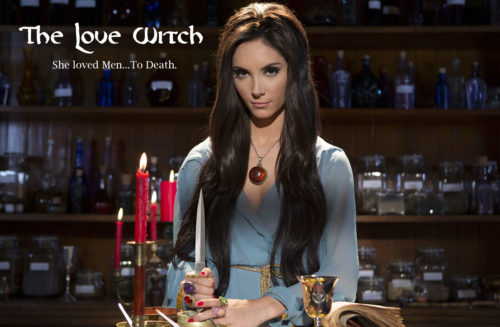
In an interview, Biller told The Wild Hunt, “I can’t remember the exact moment I decided to make this film, but it initially came from getting interested in pulp novel covers and being struck by the images of witches on some of them.” Her research began while shooting publicity stills for the film VIVA. Biller said, “The first real eureka moment I remember was being in a pulp novel bookstore in San Francisco several years ago, and picking up a 1970s pulp novel called ‘For the Witch, a Stone.’ That novel sparked the beginnings of my script.”
The Love Witch tells the story of Elaine, a single woman and Witch, who lives in northern California. We meet her as she first moves into a new apartment within a classic Victorian home. The space is owned by a friend and Wiccan High Priestess named Barbara and was decorated to reflect a Witchcraft aesthetic.The film then follows Elaine through her negotiations of love, dating, friendship and ritual practice.
It sounds as if the film might be better described as a drama or maybe even a romantic comedy. However, it’s neither. This is horror film. Elaine is a sociopath, who moves through the extremes of desire devouring men, in hopes of finding true love. The film, in many ways, can be described as George Romero’s Hungry Wives (1972) meets Bret Easton Ellis novel American Psycho. While neither work is a perfect comparison, The Love Witch fits somewhere between the two. Hungry Wives tells the story of a lost middle-age woman searching to regain her power, and ultimately finding it in Witchcraft. American Psycho tells the story of a violent sociopath who empowers himself through the extremes of a narcissistic and violent male fantasy.
Elaine, like Joan in Hungry Wives, is a victim of a male-dominated society. As demonstrated in a flashback voice over, Elaine’s father calls her stupid, crazy and “a fatty,” and her ex-husband complains about her cooking and the housekeeping. Like Joan, Elaine turns to Witchcraft to find her own power. She tells a police offer, “Witchcraft saved my life.”
Yet, at the same time, Elaine takes this self-empowerment tool to an obsessive extreme. Like American Psycho‘s Patrick Bateman, Elaine is a sociopath who functions through the realization of personal fantasy regardless of the outcome. The expression of that extreme becomes the basis of film’s theme and where it finds its horror.
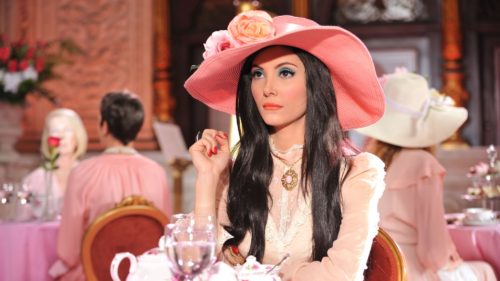
When discussing her use of horror, Biller said that she wanted to “use the genre to subvert the genre.” She explained, “When you market your film as horror it sets up certain expectations, and then through the course of the film you can subvert these expectations.”
Traditional horror films present women as the victims of male violence and aggression, the over-sexualized subject of the male gaze and the monstrous unknownable, which is often a witch. Biller says, “Elaine is not a monster, except insofar as she is selfish and narcissistic. She does not destroy out of some evil power, but because she is unstable and is the type of person who creates chaos around her. But she is fully human, and she is sympathetic because you can see why she’s turned out the way she has. So you don’t get the stereotype of an evil witch or an evil temptress.”
In addition, traditional American horror films, specifically those from the 1970s, conflate violence, Witchcraft, Satanism, occultism and voyeuristic displays of the female body. After 1968, there was a huge upswing in the number of these American exploitation films centering on Satanic witchcraft (e.g., Rosemary’s Baby, 1968; Necromancy, 1972). They were all created by men, many of whom gained notoriety making “nudies” or “sexploitation” films during the previous decade. To build their witchcraft scenes, these filmmakers relied heavily on newly published or newly available occult material by Anton le Vey, Paul Huson, Gerald Gardner, Raymond Buckland, Sybil Leek and others. They took what they needed in order to form a highly sensationalized product that fed a growing “counterculture” audience. While this particular sub-genre lost momentum by 1980, the expression of ritual Witchcraft practice has never fully emerged beyond that trope in mainstream American film.
While The Love Witch recalls those period films, in its retro styling and striking visuals. it actually subverts the genre, as Biller suggested, in a number of ways that are reflected in her presentation of Witchcraft. First, the male gaze, as defined by feminist film critic and theorist Laura Mulvy, doesn’t exist.The film’s display of nudity is not focused only on women’s bodies, but on both men and women equally. While the scenes are visually graphic, they are not exploitative. In the older horror witch films, it was typical for ritual or coven scenes to contain only naked, or partially naked, women (e.g., Blood Sabbath, 1972). There are rarely any men. In Biller’s film, both genders participate sky clad around the sabbat circle and both genders, fully clothed, serve as on-lookers in robes. There is a gender equality in the visual display of Witchcraft ritual.
All displays of female bodies in a true voyeuristic setting, such as in the dance club, are purposeful and part of Biller’s commentary as suggested by her framing choices. The camera doesn’t caress.
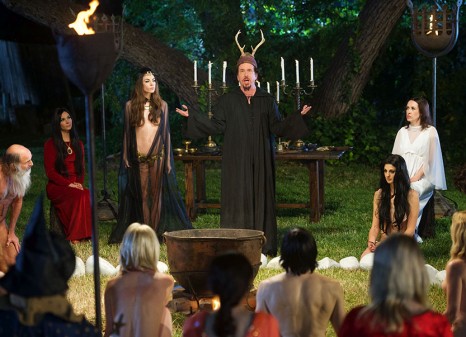
In addition, the typical horror tropes used to define Witchcraft were completely absent. The ceremonial practice is not defined as demonic-based, evil, fantastical, or derived from an historical Salem mythos. In fact, part of Biller’s project was to present Paganism in a contemporary light. To make this possible, she began her research with books and films from prominent authors, including Janet Farrar, Amber K, Aleister Crowley, Gerald Gardner, Alex and Maxine Sanders, and others. She said, “Several people in the cast who played witches were practicing witches, and I talked with them about their practices. I also lurked on internet forums and read a lot of blogs and articles, and interviewed some of my friends who are witches.”
But her work took her even further into exploring Paganism, and she reached out to the community. Biller said that, while writing the script, she attended “a few rituals, classes and study groups […] and did some solitary practice.” She added, “I have always been an uncanny sort of person and slightly psychic.” She received her first Tarot deck, the Marseilles Tarot, as a child. And, she owns a copy of a rare edition of Crowley’s Magick Without Tears, which was originally given to her father as a gift. Biller said that, while she doesn’t identify as a Witch, she does “practice magic and the Tarot at home” and “believes in spiritual entities.”
Although the presentation of Witchcraft is contemporary and remarkably accurate in many of its details, there is also a stylized exaggeration to the entire presentation that makes the Pagan reality feel completely contrived. The ritual scenes look almost like cartoon versions of Wiccan ceremonies with bold washes of color and stylized set decor. Elaine’s potion making recalls a mad scientist rather than a witch, and the coven’s unexpected appearance as Renaissance Medieval players is almost laughable.
With that said, this is just how the film represents its entire universe – not just the practice of Witchcraft. Elaine herself is caricature – a life sculpted to conform to the unreality of a heterosexual male fantasy. “Give men what they want,” Elaine advises her friend Trish. The contrived nature of the film plays out consistently from the visual elements and dialog to the narrative and themes. The large blocks of vivid color, such as the red of her purse, the purple on the walls, the blue on her eyelids, give the film a dramatic and surreal look that reflects the bizarre extremes found in the main character’s inner world.
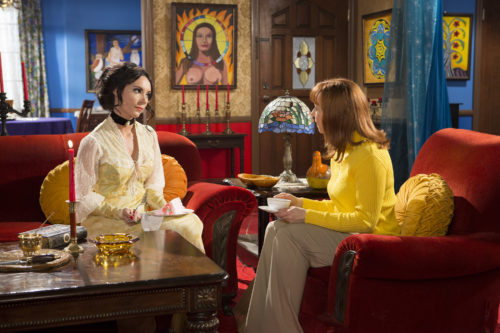
Biller said, “The design comes mostly from character symbolism. I tried to create Elaine’s character according to her self-fantasies, in which she is a sexy, 1960s-styled done-up burlesque pulp-novel cover witch who drives a cool car; the tea room is pink and Victorian as a way of pointing up Elaine’s personal fairy princess fantasies; the renaissance faire is styled liked Elaine’s wedding fantasies” And that technique goes beyond Elaine’s development. Biller said, “The police station looks like the police stations in television shows in which absolute authority was suggested, enhancing the character of the lead cop, Griff.”
This technique is partly what gives The Love Witch its theatrical, or seemingly contrived, look and feel. Although it takes some getting use to as viewer, it does work for Biller’s thesis – most of the time.
As noted earlier, Biller’s recent interest in “pulp novel covers from the ‘60s” and the way they “depicted witches as fierce powerful, sexual women,” is what led to the making of The Love Witch. She said, “I wanted to use that imagery and combine that with the feelings of persecution I’ve felt as a woman, and all of the issues women have to face with self-presentation and sexual identity in a man’s world.”
Ths film does this with no apologies.
While The Love Witch is not a completely polished film, it is packed with meaning, embedded in its stunning visuals, the use of music, and the narrative presentation. The incredible attention to symbolic detail make The Love Witch a juicy film to watch. Film buffs will enjoy the visual texture that comes across in 35 mm, if seen it in that form, as well as the careful nods to old film constructions, including the resident “expert” on Witchcraft and the close-up framing on Elaine’s eyes. Biller even employs classic high pitch repetitive noise and music, similar to what is found in Alfred Hitchcock’s Psycho (1960), to signal danger and cue tension, such as in the scene in which she first meets Wayne.
Modern Witches and Pagans will also find this film fascinating, if only because it is unusual to see Pagan practice presented in a quasi-realistic, non-judgmental, contemporary fiction setting. Many details will be recognizable, including the five-fold kiss, spoken spells and prayers, sabbats, aesthetics, and the infamous Witch’s Bottle. Interestingly, Biller even captured a modern Pagan debate. High Priest Gahan recalls the “olden days” when his community wasn’t so “uptight.” He says, “we hung Baphomet posters” and “made love freely.” According to Gahan, nobody cared whether you were a Witch, a Thelemite, a Druid a Satanist or a Wiccan.
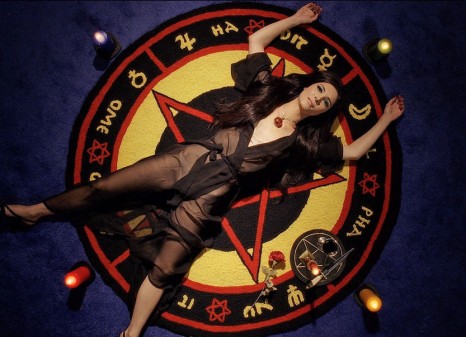
Biller’s film is a creative, aggressive and open commentary on life as a woman in modern society, both in body and heart, as well as a treatise on love as it exists between the genders. It is a horror film, not because of its use of Witchcraft, but rather because the narrative presents a uncomfortable expression of the extremes reached to fulfill a fantasy. And the ending is unsettling.
Biller wrote in a press release, “My hope is that other women will identify with Elaine as I do: as a woman seeking love, who is driven mad by never really being loved for who she is, but only for the male fantasies she has been brainwashed to fulfill.”
Currently The Love Witch is being shown only in select festivals around the world. As it gets picked up, Biller updates the screening list on her site. Eventually, the film will go to video and will be available for streaming. That date is not yet available.
The Wild Hunt is not responsible for links to external content.
To join a conversation on this post:
Visit our The Wild Hunt subreddit! Point your favorite browser to https://www.reddit.com/r/The_Wild_Hunt_News/, then click “JOIN”. Make sure to click the bell, too, to be notified of new articles posted to our subreddit.
Holy Hammer Films Batman!
Gotta love that technicolor…
I… kind of love this.
Another horror film with Witches but I have to admit, this looks good!
The presentation is not at all what you would expect.
Just watched Viva on Amazon Prime. I’m hooked.
Oh wow. The whole aesthetic is edible.
Without the explanation I wouldn’t watch this movie on a bet, but it sounds as if it might have some of the virtues of the original Wicker Man (which had a full theatrical release).
The quote from HP Gahan is historically accurate.